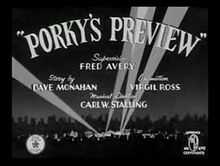Porky's Preview
| Porky's Preview | |
|---|---|
| Looney Tunes (Porky Pig) series | |
 Porky's Preview Title Card | |
| Directed by | Fred Avery |
| Produced by | Leon Schlesinger |
| Voices by | Mel Blanc |
| Animation by | Virgil Ross |
| Studio | Warner Brothers |
| Distributed by | Warner Bros. |
| Release date(s) | April 19, 1941 |
| Running time | 6 minutes 48 seconds |
Porky's Preview is a short film of animation produced by Leon Schlesinger and directed by Tex Avery. It features Porky Pig. The film was released on 19 April 1941, distributed by Warner Bros. Pictures.
Plot
Porky Pig has arranged the screening of a film in a film theater for an audience of barnyard animals.[1] The public goes to the ticket booth. A chicken buys tickets for herself and her three "children" (eggs). A kangaroo tears the tickets (and even the hand that holds it) and throws them in his pouch. A firefly usher leads the audience with his hindquarters as bright lamp. A skunk has a "scent" (pun on smelling it, and 1 cent of a dollar) and cannot enter, so he goes through the back door. On stage Porky presents the film he made himself. The accompanying music is a version of the flickering that usually introduced cartoons of Looney Tunes. The film turns out to be a series of small sketches of primitive characters drawn wire stick figures, minimalist, with settings that seem to have been penciled by a child. After the film, Porky is surprised to see the theatre in shambles the only audience that remaining is the skunk (whose presence drove away everyone else).
Analysis
The basic premise of the film is that a 7-years-old Porky has created a "homemade" animated cartoon, and demonstrates it to an audience willing to pay an admission fee. The artistic skills of the child are minimal, so the film within a film is depicted in a very simple style. Effectively serving as a parody of its art form. All fictional characters within it are drawn as stick figures, while the animation style is reminiscent of a flip book.[2]
For this film within a film, Tex Avery uses a series of blackout gags. Carl Stalling accompanies each joke with a tune already familiar to the audience. Among them are La Cucaracha (first mentioned c. 1819), Aloha ʻOe (1878), and The Old Gray Mare (written between 1875 and 1895).[2] Stalling also parodies the typical music score of shorts produced by Warner Bros. Cartoons. The credits of the film within a film makes use of The Merry-Go-Round Broke Down (1937), but the familiar tune is simplified. Giving the impression that it is played by an amateur. A number of notes are repeated, in the style of a broken record which repeats over and over.[2]
The film includes some references to war. When a skunk approaches the box office, the lady working there wears a gas mask to endure its scent.[1] The self-portrait of Porky is marked as draft No. 6 7⁄8.[1]
Edited versions
When aired on TV (particularly when aired on Nickelodeon and Cartoon Network), the "September in the Rain" segment is cut.
References
- ↑ 1.0 1.1 1.2 Shull, Michael S.; Wilt, David E. (2004), "Filmography 1941", Doing Their Bit: Wartime American Animated Short Films, 1939-1945, McFarland & Company, p. 108, ISBN 978-0786481699
- ↑ 2.0 2.1 2.2 Goldmark, Daniel (2011), "Sounds Funny/Funny Sounds: Theorizing Cartoon Music", in Goldmark, Daniel; Keil, Charlie, Funny Pictures: Animation and Comedy in Studio-Era Hollywood, University of California Press, pp. 261–262, ISBN 978-0520950122
External links
- Porky's Preview at the Internet Movie Database
- Porky's Preview at the Big Cartoon DataBase
- Porkys Preview (Colorized) on the Internet Archive